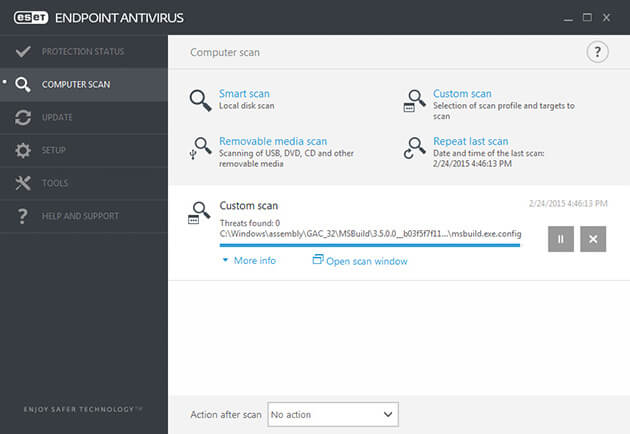
- ESET ENDPOINT SECURITY VS ENDPOINT ANTIVIRUS SOFTWARE
- ESET ENDPOINT SECURITY VS ENDPOINT ANTIVIRUS DOWNLOAD
Such companies that have primary business security functions that only need to protect individual devices, detect and remove malicious files, and provide security solutions for each workstation can benefit from just utilizing an antivirus. In short, an antivirus is a great option for startups or very small businesses without a network architecture in place.
ESET ENDPOINT SECURITY VS ENDPOINT ANTIVIRUS SOFTWARE
Deciding between an antivirus software or endpoint security solution depends on a few things like: See also: 4 Reasons Why Cybersecurity Is More Important Than Everĭeciding between antivirus and endpoint security might seem like an obvious answer after reading the above paragraphs, but not all businesses have the same needs. Not only will this save you from a major headache, but from a computer virus exposing company or personal data. So, random USBs can’t be connected unless granted access to do so. Furthermore, endpoint security limits which devices can and cannot connect to your endpoints. This makes it easy to monitor problem areas, suspicious data, traffic movement, and protect remote endpoint devices, unlike many antivirus products. department a centralized management portal, to track all endpoint devices and maintain visibility of each.

network is considered to be an endpoint, such as PCs, workstations, mobile devices, and IoT devices.Įndpoint security software also allows your I.T. Any device used by an end-user that is connected to a corporate I.T. infrastructure as a whole instead of just one endpoint. Unlike antivirus, endpoint security aims to protect the I.T. This allows for the execution of more than just that of the antivirus, but data loss prevention, sandboxing, next-generation firewalls, and endpoint detection and response. Endpoint security is made up of antivirus, firewalls, intrusion detection, and anti-malware tools. This is where endpoint protection comes in to play.


To ensure complete network security, more is needed than just malware detection and virus protection. While it is important to have an antivirus software it is not the end all when it comes to ensuring total protection for your business. As a result, antivirus operates best in environments with unencrypted data flows and for detecting simple threats. Threats are increasingly becoming signature-less or file-less, allowing for more malware to go undetected. Also, companies using legacy antivirus software depend on signature-based detection and protection of malware which is not the case anymore. The problem here is that nearly 1 million different types of malware are being released every day, thus your antivirus software must be constantly updated, which isn’t realistic or possible, to ensure it is defending against all the malicious code.
ESET ENDPOINT SECURITY VS ENDPOINT ANTIVIRUS DOWNLOAD
Whenever you download and open a file or program your antivirus software is scanning it for any malware.

Its only job is to detect and remove malware - an overarching term to describe malicious and unwanted code.Īntivirus protection works in the background while your other applications are running. It serves to protect only one endpoint the individual workstations, leaving many other endpoints vulnerable. You might also like: 5 Myths About Outdated Tech in the Workplace & What It’s Costing Youįirst off, antivirus software is only one part of the solution when it comes to protecting your business. The correct terms are ‘endpoint security’ and ‘antivirus software.’ So, what’s the difference between the two? Many people treat the terms ‘endpoint antivirus’ and ‘endpoint security’ as the same to describe solutions that protect endpoints in a network from malware attacks, when in fact they are not the same. It’s important to know the differences between some of the common terminology being used, as they are not all the same or interchangeable. Today, as cyber threats are ever-increasing, companies need more to protect themselves and their data.ĭetermining what is needed to safeguard your business can be challenging with so many options available. Previously, companies only needed minimal protection like an antivirus and firewall to combat cyber-attacks. In today’s cyber landscape there are many more complexities and vulnerabilities when it comes to staying safe from an attack and your data being secure.


 0 kommentar(er)
0 kommentar(er)
